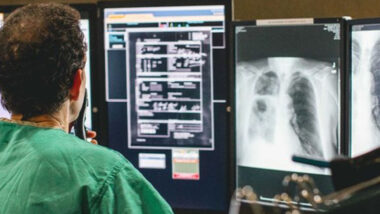More than two million Americans experience some type of rotator cuff problem every year. Your rotator cuff is a group of muscles and tendons that surround your shoulder joint and keep the arm bone within the shallow socket of your shoulder. The rotator cuff and labrum, the cup-shaped rim of cartilage that lines the ball-and-socket joint of the shoulder, are the parts of the shoulder most vulnerable to throwing injuries.
If you or your child plays baseball, softball or another sport that involves throwing, you or your child are at higher risk of a rotator cuff injury or tear. But while baseball shoulder injuries can be extremely painful, they don’t have to sideline you for good.
Why Baseball Shoulder Injuries Are So Common
Your shoulder has sturdy connective tissue, including ligaments and tendons, that keep your joint in place. The group of four muscles called the rotator cuff helps your shoulder move and stabilize and is assisted by the muscles in your back. Repetitive arm motions can lead to muscle or tendon problems.
Specifically, overhead throwing and pitching motions are very stressful to the muscles and ligaments in the shoulder, which is part of the reason why baseball injuries of this kind are so common. Baseball pitchers are at the highest risk, but any athlete who throws overhead repeatedly, including those who play softball, tennis, volleyball and some track and field events, is also at risk for muscle strain or tear.
Common types of shoulder injuries from overhead throwing include:
- Bicep tear
- Chronic shoulder instability, when you experience chronic shoulder dislocations
- Glenohumeral internal rotation deficit (GIRD), when the ligaments at the front of the shoulder loosen and the muscles at the back of the shoulder tighten, throwing off your rotation
- Rotator cuff tear
- Shoulder impingement, when tendons get pinched in between bones
- Scapular rotation dysfunction, when overuse of the muscles that connect to your shoulder blade (scapula) affects its position and causes it to droop
- SLAP (superior labrum anterior to posterior) tears, when the labrum tissue in your shoulder joint becomes damaged
- Tendinitis, an inflammation in your tendons that can lead to a tendon tear
Any one of these shoulder injuries can lead to a rotator cuff tear or another condition and can worsen with time.
QUIZ: What Is Your Diagnostic Imaging IQ?
Causes of Rotator Cuff and Shoulder Injury
Shoulder injuries can be sudden or may develop over time. Typical causes of sports injuries to shoulder muscles and tendons include:
- Direct injury to the shoulder, such as being hit with a bat or sliding into a base
- Overuse
- Poor technique when pitching or throwing
- Poor conditioning or improper weight training
While acute contact injuries on the field can be painful, chronic overuse injuries from the repetitive stress of overhead throwing often require arthroscopic surgery.
Symptoms of Rotator Cuff Injuries
Pain isn’t the only sign of a rotator cuff muscle tear or another shoulder injury, as some rotator cuff injuries don’t cause pain.
Symptoms vary by patient but may include:
- Locking or catching sensation in the shoulder
- Loss of range of motion
- Loss of throwing velocity
- Numbness in the shoulder or arm
- Weakness
How Imaging Can Diagnose Shoulder Injuries
If your doctor suspects a rotator cuff tear or another shoulder injury, the first step is a physical examination. After your doctor measures your range of motion and strength, they may order imaging to get a better picture of what’s happening in your shoulder. Types of imaging your provider may order include:
- CT scan. An advanced type of X-ray that can show bones and soft tissue in detail.
- CT arthrogram. A special type of CT scan used when assessing the structure of cartilage in joints and ligaments.
- MRI scan. Using radio waves and a strong magnet, this type of advanced imaging shows soft tissues in the shoulder in greater detail.
- Using sound waves to produce images of soft tissues, such as muscles and tendons, this imaging allows physicians to assess the structures of the shoulder in real time.
- X-rays. An X-ray won’t reveal a rotator cuff tear, but an X-ray can visualize bone spurs or other potential causes for pain and rule out arthritis.
If your shoulder injury is not severe, your physician may suggest rest or physical therapy prior to imaging to see if that solves the problem. You may also need imaging for the diagnosis of a tear and then additional imaging prior to surgery to repair a tear.
Read More: Differences Between MRI and CT Scans
Preventing Rotator Cuff and Shoulder Injuries
No one can fully prevent shoulder injuries in sports like baseball. However, certain steps can help you reduce the risk of damaging your upper arm and shoulder, including:
- Adequate conditioning. How you work out before the game matters, and maintaining a routine of strengthening exercises is important.
- Pitching limits. Youth pitching guidelines developed by baseball experts can help kids recover and prevent overuse.
- Proper technique. Adjusting your throwing motion can benefit your entire body.
- Proper warm-up and stretching. Loosening up the right way can help prevent acute injuries.
- Overuse doesn’t just happen in games. Breaks from practice or off-season training are crucial.
Trust Carolinas Imaging Services
Carolinas Imaging Services is here to provide you with advanced imaging to help diagnose your shoulder injury and help you get started on the path to recovery so you can get back out on the field.



